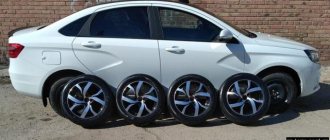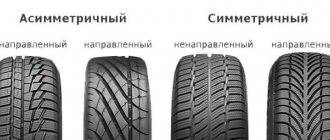Exterior view of Lada Vesta SV Cross
Already in 2021, an unusual domestically produced car appeared on Russian roads. Initially, AvtoVAZ pleasantly surprised the public by releasing the Lada Largus, and now it has offered to purchase the first crossover in its line.
Looking at this car, one immediately notices the increased ground clearance - 203 mm. This will not be enough to conquer wild off-road conditions, but it will be suitable for calmly moving off the asphalt road into rough terrain. And the black plastic body kits are another pleasant visual addition to the increased ground clearance.
Photo source: https://s1.1zoom.me/b5262/882/Lada_Vesta_Cross_Orange_Estate_car_533845_2048x1152.jpg
It is worth noting the powerful enlarged cross-shaped grille, on which a large company nameplate is located; all this is stylishly complemented by chrome inserts. The Lada Vesta SV Cross car and its increased overall dimensions rightfully draw attention to itself from cars of a similar class, such as, for example, the Kia Rio X-Line.
Future sport
The sporty Vesta has already been shown to the public; it has not yet appeared in mass production. According to official data, these will be two models with different technical characteristics: Lada Vesta Sport S-Line and Vesta R. The characteristics of the Lada Vesta Sport are as follows: one of three engines 140 hp, 150 hp or 180 hp, turbocharging, short stroke sports suspension and reinforced disc brakes. Externally, the design of the Lada vesta sport will be distinguished by bright contrasting colors, a spoiler, different bumpers and sills, a “Sport” emblem and a new instrument panel. The price of the new Vesta will be 40-80 thousand higher than usual (S-Line).
Salon
The SW did not receive any major differences from the sedan in terms of interior decoration, but still acquired several pleasant features:
- the space above the heads of rear passengers has increased by 2.5 cm;
- an armrest with cup holders was added to the rear seat;
- A separate button is now used to heat the windshield.
Less significant additions to the interior of the new Vesta are an updated soundtrack for the turn signals and additional color inserts on the door handles and dashboard.
dimensions
The main difference between the Cross station wagon and the sedan is the height; for the SV model it is 1532 mm, and this is due to the increased ground clearance. The length of the Vesta SW is 4424 mm, which is 14 mm longer than its younger brother due to the bumper pads. The body width is 1764 mm, the wheelbase and tire track are 1524 mm (remained unchanged). The total weight of the machine is 1280 kg.
You can compare the dimensions of the Lada Vesta SV Cross with another representative of AvtoVAZ - the Lada X-Ray. The latter is much inferior in length, having dimensions of only 4165 mm, but has a height of 1570 mm, which is 38 mm more than the SW.
Gearboxes
AvtoVAZ has already managed to experiment with types of transmissions on the Lada Vesta and continues to do so. The first gearbox that the model was equipped with was Renault JH3. There is nothing bad to say about the box - it was expensive for the manufacturer. From these motives they created their own new manual transmission based on the Priorovskaya one. Vestas with a French transmission are not produced today; all cars are equipped with a five-speed VAZ-21807 with a reinforced main gear, new material for rubber parts and a gear ratio of 3.9 for an engine with a capacity of 106 horses, 4.2 for 21179.
In addition to mechanics, Vesta is equipped with a Russian-made automated transmission. This is the same manual transmission, but with an electronic clutch drive, automatic gear shift mechanism and other electronics. Five-speed transmission with a gear ratio of 3.9. Lada owners have different opinions about this box. One thing is clear - without the desire to win a race and frequent driving in mountainous areas, you can drive saving on gasoline, because with the AMT robot, consumption decreases.
Work is actively underway on a CVT for Vesta. They plan to install it on the car together with the Nissan HR16 engine. We also hear about the development of our own machine gun together with foreign partners. You shouldn't expect any new products in the next five years.
Dimensions and capacity of the trunk
Another important difference between the Vesta SW Cross and the sedan is the dimensions and functionality of the trunk. It was equipped with special fastenings and drawers for storing various small items. There are also two removable trays located under a cover in the floor, their size allows you to keep many useful tools and snow brushes there. It is under these containers that the spare wheel with a stamped disk is located.
Photo source: https://www.avtogide.ru/wp-content/uploads/2017/09/4-21.jpg
If you fold the rear seat backs, you can increase the volume of the luggage compartment to 825 liters, while in the standard position the volume from the raised floor to the curtain is 385 liters. The maximum length that can be achieved if you need to transport something long and at the same time close the trunk door is 1820 mm to the back of the front seat, moved forward.
Raised floor
It’s worth studying the raised floor in more detail. Many people will not be able to understand this feature right away. Why create such a complex design given the characteristics of a station wagon? The question has many answers.
Firstly, a distinctive feature appears from many competitors, which creates the necessary marketing ploy. Secondly, there are two independent compartments that separate different chemicals and tools from each other.
The raised floor received the following dimensions:
- height with a cover – 80 mm;
- height with cover removed – 110 mm;
- length – 940 mm;
- width – 900 mm.
The raised floor structure is removable. The main frame is simply inserted into the slots provided for it. Despite the careful attitude to space, the developers made the fastenings and frame themselves massive, which takes up a little useful space.
Thanks to modern composite materials, everything can be made much more compact, but it is worth considering the emphasis on saving money - overpayment is a critical moment for citizens. The designers' decision can be justified.
Disadvantages of the trunk
And even despite the fact that Vesta SV is the leader in its class in terms of length, several main disadvantages of the luggage compartment can be identified:
- High threshold, making it difficult to load and unload heavy objects. In addition to inconvenience, such a protrusion most often becomes deformed, taking on the blows of oversized loads.
- Insufficient rear door seal. This problem does not occur in everyone and not always, but it still occurs. It appears during intensive washing; water gets into the luggage compartment, since the sealing rubber does not fit tightly to the body.
Of course, the specific owner may not notice these disadvantages, but they are found in the reviews of some drivers.
Cargo capabilities
The presence of guides on the roof involves the installation of roof rails, which will increase the amount of cargo transported. Transporting even such heavy objects as a refrigerator or sofa to the dacha will not create difficulties. High ground clearance, even with a loss of 2-3 cm, will remain suitable for driving in rural areas.
Photo source: https://www.zr.ru/content/articles/908681-ehto-vam-ne-saraj-vzorvet-li/#gal908681-1:0
In addition to everything, you can remove the raised floor cover and the trays hidden under it, increasing the luggage compartment.
Specifications
The dimensions and dimensions of the Lada Vesta SV Cross are not the only thing you should pay attention to when choosing this car. AvtoVAZ presented to the public models with both a 1.6 liter engine (with a power of 106 l/s) and a 1.8 l engine (with a power of 122 l/s) on R17 tires.
For the first option, only a manual gearbox is provided, while for a more powerful engine you can choose: manual or robotic. This engine has already been installed on a sedan and has gone through the stage of modifications; all Cross models from 2021 are free of previous shortcomings.
A nice addition for comfort lovers is cruise control and light and rain sensors. The safety system should not be overlooked; it consists of front and side airbags, as well as head restraints in the rear seats.
Of the things that could be replaced on the assembly line, these are frame wipers. For Russia, it is better to use frameless or hybrid structures. And you need to use a windshield wiper suitable for severe frosts so that the liquid in the reservoir does not freeze.
Fuel consumption: which Vesta is the most voracious
Less fuel is consumed during measured, deliberate driving. The absence of sudden braking and acceleration depends on the driver himself, however, the most experienced driver will not do without jerks in city mode. A lower-power engine and an automated transmission use gasoline more economically.
Let's start with the most economical option: a sedan with a 21129 engine (fuel tank volume is 55 liters) and a five-speed AMT. In mixed mode, consumption is 6.6 liters per 100 kilometers, in city mode - 9, in suburban mode - 5.3. A car with the same engine with a manual transmission consumes 9.3 liters in the city, 5.5 liters on the highway, 6.9 mixed. For a Lada with 21179 internal combustion engines on the robot, the numbers are as follows: city - 9.3, highway - 6, mixed - 7.2.
The Lada station wagon in the simplest configuration (106 hp, MT) consumes 9.5 liters of fuel in the urban cycle, 5.9 liters in the extra-urban cycle, and 7.3 liters in the mixed cycle. With the robot, these figures are reduced by 0.3 liters. With a more powerful engine and manual transmission, consumption in the city increases to 10.6 liters, on the highway to 6.3 liters, the average consumption rate is 7.8; with a robot, in the city you need to fill 9.9 liters of fuel for 100 kilometers; for a country trip, 6.2 liters will be enough, the average figure is 7.6. It is worth considering that 95 liters of gasoline will last a longer distance than 92 liters.
Vesta Cross is the most “voracious”. Fuel consumption in the urban cycle is 9.7 liters per 100 km for manual 1.6; 10.7 for mechanics 1.8 and 10.1 for robot 1.8. In free high-speed driving mode, the car spends 6.0; 6.4; 6.3. The combined cycle on the Lada Vesta Cross ranges from 7.5 to 7.9 liters.
What did the dimensions of the new Lada Vesta influence?
The increased length of the Vesta Station Wagon allows you to feel this not only outside, but also inside. This model is devoid of an important problem that existed in many Lada models; passengers in the rear seats no longer rest their knees on the backs of the front seats.
Photo source: https://www.zr.ru/content/articles/908681-ehto-vam-ne-saraj-vzorvet-li/#gal908681-1:0
Now this is a real family car, as evidenced by the reviews of its owners.











